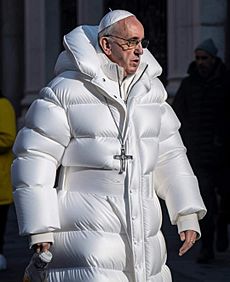Deepfake facts for kids
Deepfakes (portmanteau of "deep learning" and "fake") are synthetic media that have been digitally manipulated to replace one person's likeness convincingly with that of another. Deepfakes are the manipulation of facial appearance through deep generative methods. While the act of creating fake content is not new, deepfakes leverage powerful techniques from machine learning and artificial intelligence to manipulate or generate visual and audio content that can more easily deceive.
Deepfakes have garnered widespread attention for their potential use in creating fake news, hoaxes, bullying, and financial fraud. The spreading of disinformation and hate speech through deepfakes has a potential to undermine core functions and norms of democratic systems by interfering with people's ability to participate in decisions that affect them, determine collective agendas and express political will through informed decision-making. This has elicited responses from both industry and government to detect and limit their use.
From traditional entertainment to gaming, deepfake technology has evolved to be increasingly convincing and available to the public, allowing the disruption of the entertainment and media industries.
Detection
Audio
Detecting fake audio is a highly complex task that requires careful attention to the audio signal in order to achieve good performance. Using deep learning, preprocessing of feature design and masking augmentation have been proven effective in improving performance.
Video
Most of the academic research surrounding deepfakes focuses on the detection deepfake videos. One approach to deepfake detection is to use algorithms to recognize patterns and pick up subtle inconsistencies that arise in deepfake videos. For example, researchers have developed automatic systems that examine videos for errors such as irregular blinking patterns of lighting. This approach has been criticized because deepfake detection is characterized by a "moving goal post" where the production of deepfakes continues to change and improve as algorithms to detect deepfakes improve. In order to assess the most effective algorithms for detecting deepfakes, a coalition of leading technology companies hosted the Deepfake Detection Challenge to accelerate the technology for identifying manipulated content. The winning model of the Deepfake Detection Challenge was 65% accurate on the holdout set of 4,000 videos. A team at Massachusetts Institute of Technology published a paper in December 2021 demonstrating that ordinary humans are 69-72% accurate at identifying a random sample of 50 of these videos.
A team at the University of Buffalo published a paper in October 2020 outlining their technique of using reflections of light in the eyes of those depicted to spot deepfakes with a high rate of success, even without the use of an AI detection tool, at least for the time being.
In the case of well-documented individuals such as political leaders, algorithms have been developed to distinguish identity-based features such as patterns of facial, gestural, and vocal mannerisms and detect deep-fake impersonators.
Digitally signing of all video and imagery by cameras and video cameras, including smartphone cameras, was suggested to fight deepfakes. That allows tracing every photograph or video back to its original owner that can be used to pursue dissidents.
One easy way to uncover deepfake video calls consists in asking the caller to turn sideways.
See also
 In Spanish: Deepfake para niños
In Spanish: Deepfake para niños


